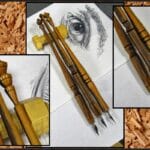Imagine a beam that combines the natural charm of wood with the resilience of steel. That’s what a flitch beam is all about! These extraordinary beams are the perfect marriage of two worlds, offering a strength and versatility that will blow your mind. So, get ready to dive into the fascinating world of flitch beams. You’ll be amazed by their history, engineering marvels, and how they’ve changed the construction game.
Understanding Flitch Beams: A Closer Look
Ever wonder how builders create those strikingly long, wooden beams gracing modern homes and renovated historical buildings? The answer often lies in a clever technique known as the “flitch beam.” This method infuses ordinary wooden beams with extraordinary strength.
What is a Flitch Beam?
Picture a well-crafted sandwich—instead of bread and fillings, envision wood and steel! A flitch beam is essentially a sandwich where a robust steel plate is nestled between two sturdy timber members. This configuration forms a single, powerful beam boasting significantly greater strength and stiffness than wood alone.
A Glimpse into the History of Flitch Beams
The term “flitch” itself carries a rich history. It originates from the traditional method of reinforcing wooden beams by splitting them lengthwise and then rejoining them, similar to slicing through a thick cut of bacon. With the advent of steel, builders recognized the potential for creating super-strong beams by sandwiching it between timber, and the name “flitch beam” stuck.
Why Choose Flitch Beams Today?
In an age of engineered wood beams, you might wonder why flitch beams remain relevant. There are several compelling reasons:
- Preserving Historical Integrity: Flitch beams are ideal for restoring old buildings. They provide the strength of steel while maintaining the classic wooden aesthetic.
- Blending Strength and Aesthetics: For those seeking the exposed wooden beam look in new homes without compromising support, flitch beams offer the perfect solution. Enjoy the beauty of wood with the hidden muscle of steel.
- Custom Solutions for Unique Projects: Pre-engineered beams don’t always meet the demands of unconventional designs. Flitch beams, however, can be custom-fabricated to suit any situation.
Advantages of Flitch Beams
- Enhanced Strength and Span: Flitch beams can handle heavier loads and span greater distances than traditional timber beams, expanding design possibilities.
- Visual Appeal: They offer the warmth and character of wood without sacrificing structural integrity.
- Timeless Elegance: Flitch beams are exceptional for preserving the historical accuracy of older structures during renovations.
Potential Drawbacks to Consider
Like any building material, flitch beams have considerations:
- Increased Labor: They demand more intricate assembly than simply installing pre-fabricated beams.
- Cost Factor: Depending on the project scale, flitch beams might cost more than engineered wood alternatives.
- Specialized Expertise: Flitch beam projects might require sourcing specialized suppliers and experienced builders.
Constructing a Flitch Beam: A Technical Overview
A glimpse into the construction process:
- Materials: High-quality timber, typically hardwoods like oak or pine, and a robust steel plate form the core components.
- Bolting Technique: The steel and wood are secured together using a meticulously planned bolt pattern. The size, spacing, and placement of these bolts are critical for ensuring the beam’s load-bearing capacity.
- Engineering Calculations: Before fabrication, engineers employ precise calculations to determine the required load capacity of the flitch beam. This ensures the beam’s structural adequacy for its intended purpose.
- Building Code Compliance: Adhering to local building codes and regulations is paramount for ensuring the safety and compliance of your flitch beam project.
The Purpose of a Flitch Beam: Strength and Versatility
We’ve explored the composition of a flitch beam—a steel and wood sandwich. But why combine these materials? This teamwork yields several benefits for builders and homeowners.
Wood, while a great building material, can sag or bend under heavy loads, especially over long distances. Steel, conversely, is incredibly strong but can be costly. Flitch beams offer the best of both worlds.
By sandwiching the steel plate between timber, you create a beam significantly stronger than wood alone. This power couple can withstand heavier loads without buckling, allowing for open floor plans with fewer bulky support columns.
This enhanced strength also allows for longer spans, accommodating wider rooms and more dramatic spaces. Architects and designers favor flitch beams for creating airy, open-concept homes without compromising safety.
While solid steel beams can be expensive, flitch beams can be more budget-friendly, striking a balance between strength and cost.
Furthermore, flitch beams offer design versatility. For a trendy industrial aesthetic, leave them exposed. For a more traditional look, conceal them within the structure.
These versatile beams find applications in various settings: floor joists, roof beams, heavy-duty headers over large openings, balconies, mezzanines, decks, and even bridges.
Flitch beams represent a time-tested solution in construction, offering strength, adaptability, and aesthetic appeal.
Exploring Flitch Beam Span: Factors and Considerations
Determining the maximum span of a flitch beam is not a one-size-fits-all calculation. Several factors come into play.
Typically, a flitch beam can span up to 25 feet without additional support. However, this is a general guideline. The actual span depends on factors like the thickness and type of wood, the size of the steel plate, and the anticipated load.
Think of it like this: a beam supporting a library of books needs to be more robust than one holding a few decorative items.
Extending beyond the 25-foot benchmark is possible with careful engineering. Strategic placement, additional supports, and advanced techniques can increase the potential span.
While the 25-foot mark serves as a common reference, it’s crucial to remember that construction technology is constantly evolving. New materials, techniques, and research emerge frequently. What we know today about maximizing flitch beam spans may be just the beginning.
Flitch Beam vs. Steel Beam: Understanding the Differences
Let’s delve into the distinctions between these two beam types. Imagine you’re building a house—you need a strong foundation. Beams provide this backbone.
One primary difference lies in their composition. As the name suggests, a steel beam is made entirely of steel. A flitch beam, as we’ve discussed, combines wood and steel. This hybrid structure allows the flitch beam to achieve remarkable strength while remaining lighter than a solid steel beam.
Consider lifting a heavy box. A steel beam is like lifting the entire weight at once—strong but heavy. A flitch beam, due to the wood, is like having handles on that box. It’s still strong enough for the task but more manageable. This weight difference is crucial in construction, where every pound counts.
In terms of cost, steel beams tend to be more expensive than flitch beams, particularly for smaller-scale projects like houses. Flitch beams offer a balance of affordability and strength for renovations or additions where budget is a concern.
However, steel remains the undisputed champion of pure strength. For skyscrapers or bridges, the unparalleled strength of steel is essential.
Think of a flitch beam as a reliable pickup truck—strong and dependable for everyday jobs. A steel beam, on the other hand, is like a heavy-duty semi-truck built for the most demanding hauls.
As scientists and engineers continue to innovate, the beams of the future may be even more advanced than those we use today.
Flitch Beam Analysis: Outperforming Your Competitors
Recommended Titles:
To recommend titles, please provide the collection of trending article titles from your competitors.
Powerful Key Lines:
- Flitch beams: Combining the beauty of wood with the strength of steel for superior structural support. (This key line highlights the dual benefits of aesthetics and strength)
- Once a cost-effective solution for long spans, flitch beams now find their niche in historical renovations and unique architectural designs. (This key line acknowledges the historical context while highlighting current applications)
- Though less common in modern construction due to engineered lumber, understanding flitch beam principles is valuable for historical preservation and specialized projects. (This key line emphasizes the enduring relevance of flitch beam knowledge)
- Proper flitch beam design requires careful consideration of load distribution, bolt spacing, and material properties for optimal performance. (This key line emphasizes the technical aspects and importance of proper design)
Important Details for Your Article:
1. What is a Flitch Beam?
- Definition: A compound beam typically consisting of a steel plate sandwiched between two wooden beams, secured with bolts.
- Purpose: To increase the load-bearing capacity of a wooden beam, particularly over long spans.
2. Historical Context:
- Origin of the term “Flitch”: Derived from a slab of bacon cut into strips, mirroring the early practice of splitting and rejoining wooden beams for enhanced strength.
- Evolution of Flitch Beams:
- Initially involved sandwiching hardwood like oak within softer wood like pine before steel became readily available.
- The introduction of affordable steel transformed flitch beams into a cost-effective solution for reinforcing long-span wooden structures.
- Example from 1883: An article in The American Architect and Building News compared different beam options for a hypothetical railway station, highlighting the flitch beam’s cost-effectiveness and fire-retardant properties.
3. Modern Uses:
- Historic Renovations: Reinforcing existing aged lumber supports while maintaining the aesthetic appeal of wood.
- Aesthetic Applications: Achieving the desired look of exposed wooden beams with the added strength provided by the concealed steel plate.
- Specialized Projects: Utilized in situations where engineered lumber might not be suitable or desirable.
4. Advantages & Disadvantages:
Advantages:
- Increased Strength and Span: Significantly enhances the load-bearing capacity of wooden beams, allowing for larger spans.
- Aesthetic Appeal: Preserves the visual warmth and character of wood while providing hidden structural reinforcement.
- Historical Authenticity: Ideal for maintaining the historical integrity of older structures during renovations.
Disadvantages:
- Labor Intensive: Requires specialized fabrication and installation compared to engineered lumber.
- Cost Considerations: While historically cost-effective, modern alternatives like engineered lumber can be more economical in some cases.
- Less Common: May require sourcing from specialized suppliers.
5. Design and Construction:
- Materials: Typically uses a combination of steel plates and wooden beams (species and dimensions vary based on the application).
- Bolting Pattern: Critically important for transferring loads effectively between the steel and wood components. Bolt size, spacing, and placement are carefully calculated based on the specific design requirements.
- Load Calculations: Structural engineers must accurately calculate the expected load to determine the appropriate size and configuration of the flitch beam.
- Building Codes: Adherence to local building codes and regulations is essential to ensure structural safety and compliance.
Unique Insights and Untapped Potential:
- Focus on Sustainability: Explore the environmental impact of flitch beams compared to modern alternatives, considering factors like material sourcing and embodied energy.
- Case Studies: Showcase successful examples of flitch beam use in modern restoration projects or unique architectural designs.
- Comparison with Engineered Lumber: Provide a detailed comparison between flitch beams and engineered lumber, analyzing their respective strengths, weaknesses, and ideal applications.
- DIY vs. Professional Installation: Discuss the feasibility and limitations of DIY flitch beam installation, emphasizing the importance of professional structural engineering advice for load-bearing applications.
Remember:
- Back up your claims with credible sources and link to relevant studies or articles.
- Use high-quality images and diagrams to illustrate key concepts and make your article visually engaging.
- Optimize your content for SEO by using relevant keywords naturally throughout your text.
Additional Insights to Consider
- Connection to Other Topics: While discussing the importance of safety and seeking professional expertise, you could subtly connect to a related article about the dangers of improper construction, such as the cottonmouth snake article you provided. For example, “Just as it’s crucial to be aware of potential hazards in nature like the venomous cottonmouth snake, understanding the complexities of structural engineering and seeking expert advice is paramount for ensuring the safety and integrity of your building projects.”
By incorporating these elements and addressing the identified gaps, you can create a comprehensive and authoritative article that surpasses your competition and captures the attention of your target audience.











